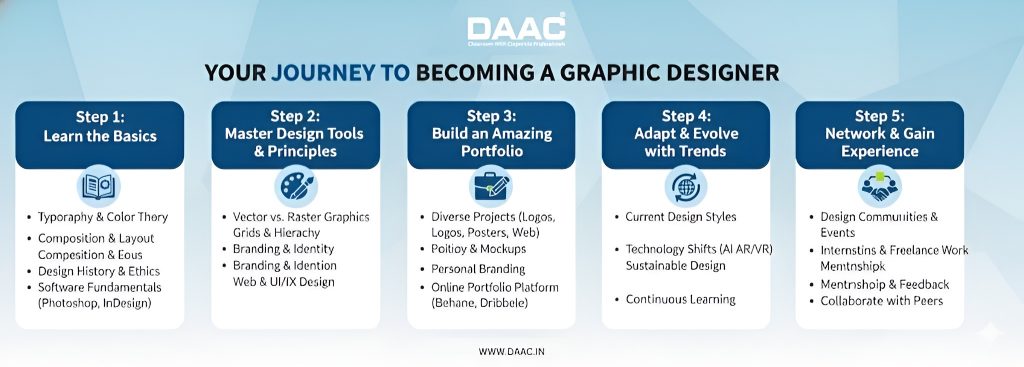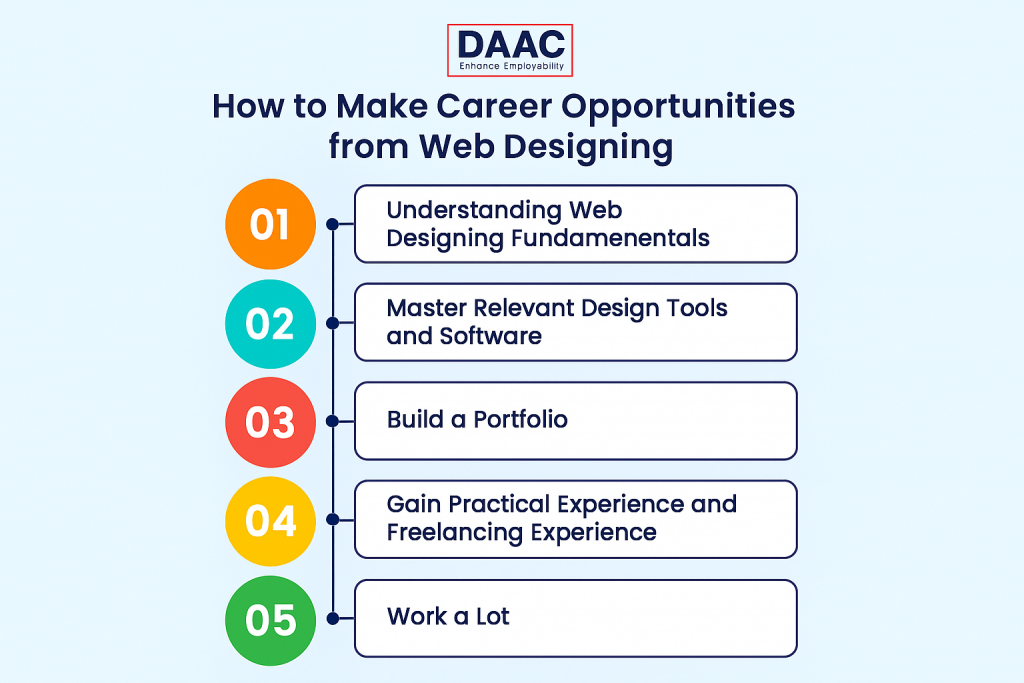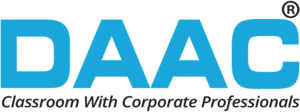How to Start a Career in Web Designing?
UI/UX DESIGNING October 13, 2025

Career in Web Designing: In today's digital-first world, one of the highest-paid and most innovative careers one can choose is a beginner-friendly career in web designing. Every small or large business needs a website, and that is why well-qualified web designers are always in demand in industries. If you get any inclination towards design, user experience, or coding, you can have ample opportunities for your innovation and growth by starting your career in web designing from the beginning.
Key Takeaways
- For newbies, the web design market is full of innovative and economic development possibilities.
- With the appropriate skills, access to resources, and attitude, you can convert your design passion into a flattering profession.
- Mastering web development and design principles and developing a robust portfolio are the initial steps towards becoming a competent web designer.
- Long-term viability requires continuing education and keeping abreast of new design directions.
Market Analysis Report: Global Web Designing Industry (2025)
- The web development and design market worldwide will exceed USD 65 billion by 2025, at a growth rate of about 8–10% per year on average.
- When it comes to demand, the geography demonstrates that Asia-Pacific and North America lead the way, due to startup development and reshaping Internet strategy.
- Globally, over 70% have made continued investments in responsive design and UI/UX.
- Growth of e-commerce, mobile-enabled sites, and AI design tools (e.g., Figma, WebFlow) have helped fuel the hiring of premier designers.
- Career opportunities for web design among youth is on the increase, especially for HTML, CSS, JavaScript and design fundamentals in UX.
- It is evident from the market trend that web design careers are future proof, and offer creative freedom along with good financial stability.
What Is Web Designing
Web design is the process of building, designing, and updating websites which promotes a positive and functional user experience. It involves aesthetics, layout, organization of content and interactivity. For a junior web designer to have a successful career you will learn to design applications (Adobe XD, Figma, and Canva) and have front-end programming knowledge (JavaScript, CSS, and HTML) but for a junior web designer you should make a site look professional, easy to use and on brand.Steps to Develop a Web Designing Career
Step 1: Learn the Basics:
Begin by learning the fundamentals of HTML, CSS, and JavaScript, the building blocks of web technologies. Learning how these technologies interact with each other helps you lay down some basic understanding of what is entailed with web design. With these baby steps under your belt, you can design simple web layouts and bring some of your visual ideas to life.Step 2: Learn Design Tools and Principles:
Acquire real-world experience with tools such as Figma, Adobe XD or Sketch. These are essential tools for building out user interface designs and prototypes. In addition, you can learn design principles such as color theory, typography and composition of layouts so that you can build engage designs.Step 3: Create an Amazing Portfolio:
Start by creating personal projects or redesigning existing website designs to put your knowledge into practice. A solid portfolio showcases both your creativity and technical training, and can help you stand out whether you're seeking employment or freelancing.Step 4: Request Change with Trends:
Design is always changing, and it can be helpful to wrap your head around new trends like responsive design, mobilization, and AI-based tools. Be aware of new technologies, and your work will seem fresh, modern, and competitive.Step 5: Network and Gain Experience:
Join online design communities, attend a webinar, and collaborate with a developer or another designer. Networking will also connect you to mentorships or internships or freelance projects that increase your experience.
Features of Web Designing
Effective web design combines creativity and technology to produce a site that is fun to use, easy to navigate and loads well. Using the appropriate design characteristics will improve user experience, determine brand identity, and increase business sales.Responsiveness:
Design a site that looks good and behaves well on every device called mobile, tablet, and desktop respectively ultimately sets a stage for users to navigate without interruption, flow, or redundancy of function.Loading Speed:
Using compress images, clean code, and an intelligent design will reduce load time, keep users engaged, and improve search engine rankings.User-Friendly Navigation:
Well thought out site navigation will entice visitors to explore the site and find what they are looking for easily and without frustration.SEO:
Using SEO-friendly characteristics in the site design (keywords, meta tags, mobile friendly) will improve site visibility and generate additional organic traffic.Visually Appealing:
Making a site look appealing with appropriate colors, fonts, and graphics to hold the attention of the user is suggestive not only of good design, but of brand identity which ultimately makes for a great user experience.How to Make Career in Web Designing?
Establishing a career in web design allows you to experience rewarding creative and professional opportunities in the digital landscape. If you're a recent graduate, or if you're interested in changing career paths, knowing what to move into can make a difference. Below is a pathway to success in becoming a web designer, and opportunities for freshers in web design.- Understanding Web Designing Fundamentals: In order to begin your career path in web designing for beginners, you should understand the fundamentals of web design. Learn the basic web technologies that are the building blocks of all websites, which are HTML, CSS, and JavaScript. Knowing how HTML, CSS, and JavaScript work together as specific web technologies will help you design effective and informative websites that are responsive and interactive. Aside from coding, you should also establish a well-designed website based on the principles of design (such as layout, color theory and typography), so that the resulting website not only looks good, but also creates good user experiences.
- Master Relevant Design Tools and Software: As mentioned, one of the essential steps in understanding how to start a career in web designing from the ground-up, is mastering the relevant tools. Get acquainted with the design software you'll be using such as Adobe XD, Figma, Photoshop, or Sketch so that you can start designing layouts, mockups, and prototypes. These programs will be essential to creating your design ideas and communicating effectively with clients or developers. As you develop your technical and visual skills, the designs you create will develop into more industry standard quality and market ready.
- Build a Portfolio: When you are starting out as the role of web designer, your portfolio will be the most valuable part of your brand. Curate a collection of the strongest web design examples to present your creativity and skills as well as your ability to deliver solutions as solutions for the client. Aim for a mixture of personal projects, redesigned websites, and ideal-world projects if you have them. Having an online portfolio that is organized and flows well can function as a digital resume for web designers in an overly crowded and competitive market.
- Gain Practical Experience and Freelancing Experience: When you've attained proficiency in the area of study, put it in use in practice. Freelancing is a way to gain experience and establish yourself as a web designer. You can find lots of work through Upwork, Fiverr, and Behance. It's helpful having real clients and projects to understand what it takes to complete a project, how to negotiate timelines and deadlines, and how to effectively communicate with clients. All core aspects of being a professional web designer.
- Work a Lot: One of the best things a designer can do is purchase and study successful web design projects on their own time. The ultimate goal is to fully understand the way successful designs are designed, built, change over time, or improved upon. There are so many books that cover content and site design, but the key is to build your skill set with real design (not so much academic design), if that's what you plan to pursue. It is beneficial to take a constructive look into successful web design, whether studying books or the web. Keeping up to date with successful design will produce long-term growth, so you'll be consistently ahead of the curve in your desire to stay relevant in the field of web design. If you want to become career in web designning, Join the DAAC web design course in Jaipur.
 Web design refers to the process of constructing, designing, and sustaining websites that deliver an enjoyable and useful experience for the user. It includes areas such as aesthetics, layout, formating content, and interactivity. To ensure a successful career as a novice web designer, you will learn design tools (Adobe XD, Figma and Canva), and front end programming avareness (JavaScript, CSS and HTML), but as a novice web designer you need to design a site that looks professional, is user friendly, and is on brand.
Web design refers to the process of constructing, designing, and sustaining websites that deliver an enjoyable and useful experience for the user. It includes areas such as aesthetics, layout, formating content, and interactivity. To ensure a successful career as a novice web designer, you will learn design tools (Adobe XD, Figma and Canva), and front end programming avareness (JavaScript, CSS and HTML), but as a novice web designer you need to design a site that looks professional, is user friendly, and is on brand.
FAQs About Career in Web Designing
- Can designing be considered a starter career?
- How can I have a career in web designing without experience?
- What is needed in a career in web designing?
- How can a web designer work?
- How is the way towards becoming a successful web designer?
